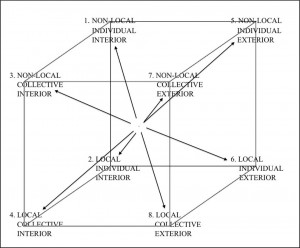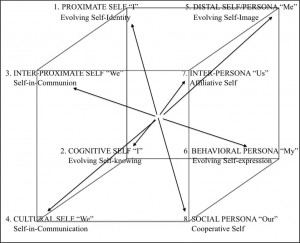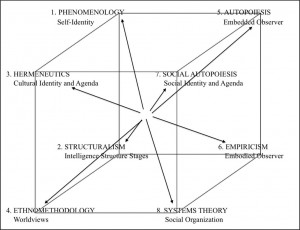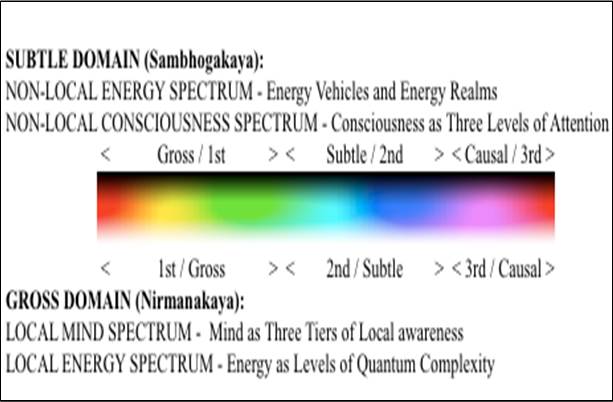Lexi Neale

Lexi Neale
Author’s Note: The above title is not intended to be demeaning, dear Reader, but more of an inside joke between Russ and I. Russ has twice approached me about an AQAL Cube article, and has twice shied away from what I sent him. His complaint? Too complex! So I have finally relented and taken his observation to heart. I sincerely hope that the following extension of Ken Wilber’s AQAL Square model is at least comprehensible, if not acceptable!
Since Ken introduced my AQAL Cube extension of his Integral model, the AQAL Square, on kenwilber.com, archived June 12th 2009, it has been “the best of times, and the worst of times” (A Tale of Two Cities) as in a tale of two models. In an introduction he wrote for Part 2, archived November 4th 2009, where I pitched the AQAL Cube as Wilber-6, he said “In my mind, of course, it is definitely not Wilber-6, just a thoughtful extension of Wilber-5.” And in my mind, of course, I am still challenging that!
It is true that the AQAL Cube vastly complicates the Integral model by introducing AQAL Non-locality into the mix, and also the liberal notion of Eight Fundamental Perspectives PER PERSON, but the complication has more to do with the effort of having to transcend/include establishment Integral concepts rather than complexity per se. I let you be the judge of that. Going back to Ken’s comment “a thoughtful extension of Wilber-5”, I decided that should be my guide in writing this article, by keeping to the aspects of the AQAL Cube that truly are extensions of the AQAL Square.
The AQAL Cube as the Eight Fundamental Perspectives
The year before Ken first saw my AQAL Cube submission for The AQAL Journal, his latest work “Integral Spirituality”[1] came out in 2006. It introduced the most radical notion since the Four Quadrants map in 1995, which he called the Eight Fundamental Perspectives. Until then there had been only Four Fundamental Perspectives: Individual Interiors (Upper Left Quadrant), Collective Interiors (Lower Left Quadrant), Individual Exteriors (Upper Right Quadrant) and Collective Exteriors (Lower Right Quadrant). Suddenly, each of those Quadrants were endowed with an extra perspective polarity, called “Inside” and “Outside” views, resulting in 2 x 2 x 2 = 8 Fundamental Perspectives.
It made perfect sense, because we truly do have an “Inside” and “Outside” take of the Four Quadrants. It is a differentiation of our sense of Self that enables us to perceive this. But Ken received Holy Hell from many Integral traditionalists for introducing an additional polarity (Inside/Outside) that could not be empirically accounted for – and is still not accounted for in the AQAL Square model. Obviously it is a consciousness-related issue, but how does it differentiate in the obvious way that Individual does from Collective, and Interior does from Exterior? Enter the AQAL Cube.
The AQAL Square becomes the AQAL Cube by differentiating two orders of reality that underly our sense of “Inside” and “Outside”. And it accomplishes this by introducing the latest scientific field to differentiate itself from Quantum Physics, called Quantum Consciousness. Now Quantum Consciousness is as much the “bad boy” of Quantum Theory as the AQAL Cube is the “bad boy” of Integral Theory. In other words, I feel in good company!
From its outset as a very questionable field of research in the 1920’s, when even Einstein himself derided it, the observed “unruly” behavior of Quantum energy became a huge issue. Heisenberg even described it as the effect he called the Uncertainty Principle, which stands to this day. The origin of the “unruly behavior” was traced back to the consciousness of the experimenter, whose mind set could influence the outcome of Quantum measurements. The horrifying inference was that Energy and Consciousness are inter-relatable. To this day, modern science has barely been able to address this empirical “embarrassment” of Newtonian and Einsteinian Physics. And Integral science is no better.
Quantum Consciousness research[2,3,4] is showing that Energy and Consciousness are spread over two Domains: Locality and Non-locality. Locality is where we feel safe because it is our Physical Universe, where everything behaves itself according to the Laws of Newton and Relativity. But Non-locality is not of this Physical Universe. The speed of light and gravitation constants no longer apply. Non-local Quanta can be “everywhere at once”, and even predict future events in Locality. “Weird science” indeed, even “scary” to some, but empirical nevertheless. It is just and fitting that Integral Theory has to be the one to include these phenomena if it is truly to live up to its name “Integral”. Problem is, the AQAL Square is not up for it until Ken’s “Inside” and “Outside” arenas have been properly defined.
Ken himself anticipated a solution in “Integral Spirituality” when he described our perception of reality as “perspectives taking perspectives” using the Eight Fundamental Perspectives. With only one Quadrant to help him here, the Upper Left, he said that our Self-awareness is our “Inside” view and our Cognitive-awareness is our “Outside” view. And that balanced perception is when the altitude of our Self correlates with our Cognitive altitude. If our Self is in Green and our Cognition is in Red, or vice versa, we are in trouble. So right there, does “Self awareness” and “Cognitive awareness” pertain respectively to Non-local and Local awareness? Quantum Consciousness research with Roger Penrose and Stuart Hameroff[5] is showing a tentative “yes”; but their problem is that they don’t have a model to demonstrate it. Once again, enter the AQAL Cube Fig.1.

Fig. 1. The AQAL Cube
The Eight Fundamental Perspectives above are numbered as per Integral Theory.
As a result of Quantum Consciousness and Noetics research[6], it is becoming increasingly clear that Non-locality, meaning non-physical existence, is the seat of Consciousness; and that Locality, meaning of this Physical Universe, is the arena of its enactment. Consciousness is like the driver of a car. To further that analogy, it is like Consciousness (Self-awareness) drives a vehicle that has programmable software called the Mind (Cognitive awareness). As the driver evolves, the cars become more sophisticated and powerful. Eventually the driver builds the ultimate car to win the Grand Prix of Consciousness called Enlightenment. The point being, Self-awareness on the Spectrum of Consciousness co-evolves with Cognitive-awareness on the Spectrum of Mind. As Ken said, it is the Climber and the Ladder, but Integral Theory has yet to differentiate the two as an AQAL Cube with Non-local and Local Perspectives.
The AQAL Cube per Person
Now we go deeper into our Self-system. Ken’s AQAL Square affords the Self-system two First Person Quadrants (Upper and Lower Left). Ken himself has said that the AQAL Square is really a Third Person model describing First, Second and Third Person phenomena. We now reconsider that blatant admission of flat-land. This is where established Integral Theory gets taken for a really wild ride in a very powerful car!
Remembering how Ken’s Third Person “Inside”’, “Outside”, “Individual”, “Collective”, “Interior” and “Exterior” perspectives recombine to produce the Eight Fundamental Perspectives (Fig. 1), the same logic can be applied to our First Person: As well as our Consciousness Self and our Cognitive Self we also have a Singular Self, a Plural Self, a Subjective Self, and an Objective Self, which recombine in the same way to produce the Eight Fundamental First Person Perspectives. Suddenly our two-cylinder car becomes a V-8!
Since the beginning of language the First, Second and Third Person pronouns have defined our self and each other: Me Tarzan, You Jane. And it is in language that we express our intuitive knowledge of our own Self complexity. Fig.2. shows the First Person Cube and its eight First Person pronouns expanding through the Levels.

Figure 2. The First Person Cube
The Quadrants above, 1,3,5,7 are the Non-Possessive Personal Pronouns, and the Quadrants below, 2,4,6,8 are the Possessive Personal Pronouns. The first thing that is apparent is how the Non-Possessive Quadrants 1,3,5 and 7 are intangible First Person identities, and how the Possessive Quadrants 2,4,6 and 8 are tangible First Person experiential attributes of those identities. The differentiation is exactly the same as between Non-Local Consciousness and Local Body-Mind. In other words, our entire cultural history has endorsed the notion of a Four Quadrant “Experiencer-as-Consciousness”, and a correlated Four Quadrant “Experience-as-Mind”.
The second thing we notice about the First Person Cube is that there is no differentiation in English between the two “I’s” and ”We’s” as First Person pronouns in the Subjective Octants 1,2,3 and 4. Language is a two-way street: One the one hand it identifies pre-existing perspectives as a common experience, which then become cultural givens; but on the other hand, in naming them, it can culturally bias some perspectives at the expense of others. Cultures that are objective diminish the subjective; cultures that are collective diminish the individual; cultures that are materialistic diminish the non-material – by not differentiating them. In Russian there is a differentiation between an “inner We” and an “outer collective We” as in “We the people”. In Yiddish there is a differentiation between “I” as a spiritual identity and the “I” of everyday life.
In evaluating his “8 Zones”, Wilber encountered this anomaly himself in differentiating an Inside “I” from an Outside “I”; and an Inside “We” from an Outside “We”. I quote[7]:
‘ – for example, the experience of an “I” in the UL Quadrant. That “I” can be looked at from the inside or the outside. I can experience my own “I” from the inside [Octant 1], in this moment, as the felt experience of being a subject of my present experience, a 1st person having a 1st person experience. If I do so, the results include such things as introspection, meditation, phenomenology, contemplation, and so on (all simply summarized as phenomenology… But I can also approach this “I” from the outside [Octant 2], in the stance of an objective or “scientific” observer. I can so in my own awareness (when I try to be “objective” about myself, or try to “see myself as others see me”) …Likewise, I can approach the study of a “we” from its inside or its outside. From the inside [Octant 3], this includes the attempts that you and I make to understand each other right now. How is it that you and I can reach a mutual understanding about anything, including when we simply talk to each other? How do your “I” and my “I” come together in something you and I both call “we” (as in, “Do you and I – do we – understand each other?”). The art and science of we-interpretation is typically called hermeneutics.
‘But I can also attempt to study this “we” from the outside [Octant 4], perhaps as a cultural anthropologist, or an ethnomethodologist, or a Foucauldian archaeologist…And so on around the quadrants. Thus, 8 basic perspectives and 8 basic methodologies.’ (The Octant designations in brackets are mine.)
In other words, Wilber completely endorses the Left Octants (1,2,3 and 4) of the First Person AQAL Cube, but he does not extend this argument to the First Person Right Hand Quadrants (5, 6, 7 and 8). He does, however, mention the objective-self issue:
‘If you get a sense of yourself right now – simply notice what it is that you call “you” – you might notice at least two parts to this self: one, there is some sort of observing self (an inner subject or watcher); and two, there is some sort of observed self (some objective things that you can see or know about yourself… The first is experienced as an “I”, the second as a “me”… I call the first the proximate self (since it is closer to “you”), and the second the distal self (since it is objective and “farther away”).’
The Proximate and Distal Selves are an Octant 1 and Octant 5 differentiation on the First Person AQAL Cube. Octant 5 is the Distal Self, or the way I formulate my Proximate Self as a Persona in its true etymological sense, as my mask, as how “I” want others to identify with “Me”. This is the All Level “Me” Inside. (Note: This differentiation of the Distal Self or Persona is not the persona of fulcrum 4.) And the correlated behavior of this Persona is “My” personality Outside, where Octant 6 pertains to “My” personality through “My” behavior. The Enneagram as elucidated by Riso[7] makes this differentiation very clearly.
Equally, the Social Persona or our identification with “Us” Inside, and the Social Personality-behavior in “Our” tribe Outside, follow the same First Person differentiations. These eight important First Person Self-differentiations have not yet been made in Integral Psychology, even though they are experientially self-evident to the point where Wilber himself identified six of them, with “Us”.
Integral Theory does in fact obliquely identify the Self-system as a First Person Octo-Dynamic. I noticed how the various Lines of the Self System in the AQAL Square Upper Left have an eerie correspondence with the First Person Eight Fundamental Perspectives. Naturally, this needs to be played out in Integral Research, but I propose that the correspondence self-evidently corroborates the First Person AQAL Cube:
Octant 1: Proximate Self as the Consciousness-as-experiencer “I”. Core self-identity witnessing through Levels of assumed identity states. Lines: Proximate Self-identity, spiritual identity. Representative Levels of Self-identity-as-witness are: Red – Id identity fused with the Lower Mind; Orange – Ego identity fused with the Lower Mind; Blue – Soul Consciousness differentiated from Mind. Violet – Non-Dual Supreme Witness.
Octant 2: Cognitive Self as the “I” Mind. Experiential identity through Fulcrum Levels of intelligence structures. Lines: All Intelligences, such as cognitive, affective, psychosexual, aesthetic, spiritual. Representative Levels of experiential intelligence are: Red – sensing, feeling, emoting; Orange – thinking; Blue – visioning; Violet – wisdom/Akashic experience.
Octant 3: Inter-Proximate Self as “We” Consciousness. Shared self through Levels of assumed identity states. Line: inter-proximate self. Representative Levels are: Red – Inter-Id as fused “I-We”; Orange – Inter-Ego “We”; Blue – Inter-Soul “We”; Violet – Non-Dual “We”.
Octant 4: Cultural Self as the “We” Mind. Interpretive shared or common experience as cultural intelligence. Lines: moral self, worldview self. Representative Levels are: Red – Tribal member (fused “I-We”); Orange – cultural independent; Blue – cultural visionary; Violet – spiritual iconoclast.
Octant 5: Distal Self (Persona) as “Me” Consciousness. Objectively differentiated from the Proximate Self of Octant 1, the Persona is self-referential as a Self-image. This is the intentional persona of the Enneagram, the objective evaluator of the Self-system and home of the Self-judging Super-Ego. After death existence or Bardo is a projection of this self-evaluation as our Non-Local All-Level Persona. Line: intentional persona. Representative Levels as State-stages are: Red – Id-centered, 4th Bardo; Orange – Ego-centered, 3rd Bardo; Blue – Soul-centered, 2nd Bardo; Violet – Pneumo-centered, 1st Bardo.
Octant 6: Behavioral Persona as “My” Mind. Objectively differentiated from the Cognitive Self of Octant 2, the Behavioral Persona is the objective expression of Mind as our Personality and its Enneatypes. Lines: behavioral personalities as applied to cognitive, affective, psychosexual, aesthetic, spiritual. Representative Levels as Structure-stages are: Red – magic; Orange – rational; Blue – integral; Violet – spiritually wise.
Octant 7: Inter-Distal Persona as “Us” Consciousness. The Social Self-image is a fused “Me-Us” until socio-centric, after which the Social Identity differentiates. Identification with family, organizations and affiliations. After-death identification with others is through the correlated Non-Local All-Level Social Persona. Line: interpersonal. Representative Levels as State-stages are: Red – symbiont; Orange – server-dominator; Blue – integrator; Violet – compassionate.
Octant 8: Social Persona as “Our” Mind. The Social Persona evolving as organized and cooperative behavior and experience of social situations. Lines: sociocultural, relational, ethical. Representative Levels as Structure-stages: Red – tribal member; Orange – nationalist; Blue – globalist; Violet – utopian.
In the interests of developing a fully Integral model, I suggest that Integral researchers of the Self-system identify their field of research as an Octant in each Person.
It is in Third Person that Integral Theory goes fully AQAL Cube, as in Fig. 3 .

Figure 3. The Third Person AQAL Cube
Here it is self-evident how our Eight Fundamental Third Person Perspectives derive from the Non-local Quadrants and Local Quadrants of our First Person Perspectives.
In other words, what we have just mapped out is essentially the missing half of the Integral Model. We examine this next, where we attempt to demonstrate that our entire “Inside” existence is in fact our AQAL Subtle existence, our entire “Outside” existence is in fact our AQAL Gross/Physical existence, and that the two co-evolve towards Non-dual existence.
AQAL Cube Octo-Dynamics
Integral Theory’s AQAL Square model maps our evolution (the Climber) through the Gross, Subtle and Causal Levels of existence as a linear sequence of structural Levels (the Ladder). Integral Theory’s structural Levels through the Four Quadrants of the AQAL Square pertain to increasing physical complexity through Gross, Subtle and Causal physical structures, but do not pertain to the Subtle and Causal Domains per se. This is a perfectly valid First Tier view, because First Tier awareness (Gross) does not have access to Second Tier (Subtle) and Third Tier (Causal) awareness. And for this reason the AQAL Square, as a First Tier model, is incapable of modeling the Subtle and Causal Domains. Once again, enter the AQAL Cube.
Quantum Non-locality is not separate from Locality. Non-locality is embedded in and embodied by Locality in exactly the same way that the Subtle Domain is embedded in and embodied by the Gross Domain. The AQAL Cube as a Second Tier model on the one hand maps AQAL Locality as full-spectrum Gross existence, and on the other hand maps AQAL Non-locality as full-spectrum Subtle existence. In other words, the AQAL Cube models the octo-dynamics between AQAL Subtle and AQAL Gross co-existence and their co-evolution. As an evolving entity, our Subtle vehicle (Sambhogakaya) is our AQAL Consciousness “Inside”; and the Gross vehicle (Nirmanakaya) we occupy, or incarnate into, is our AQAL Body-Mind “Outside”, as shown in Fig. 4

Figure 4. The Subtle and Gross Domains as Full Spectrum
“Evolution”, as it is debated conventionally AND Integrally, is always about evolution in this local, physical universe. Admittedly, the Integral debate does extend the issue to evolving through the Spectrum of Consciousness, but only in the context of First Tier awareness as physical Life/Mind processes. Even though Ken’s Spectrum of Consciousness extends to Subtle and Causal Levels, our evolution into these higher Levels of awareness is nevertheless physically “explained” in the AQAL Square context of Locality as fulcrums (UL), correlated physical structures (UR), and Cultural (LL) and Social (LR) structures of increasing complexity.
All this, of course, is a classic, be it Integral, view of the organic evolution of Life-forms into greater awareness, as the result of sentient individuals living incrementally more progressive (complex) lives that their progressive offspring, in turn, take incrementally further. This says a lot for the evolution of AQAL physical structures, but says little about the evolution of the individual awareness beyond the context of the single life of that physical individual. The result of all this trying to “explain” any purpose to this individual process, as a part of “explaining” evolution overall, is a problem that has existed for as long as evolutionary theory itself: Some “engine” of progress has to be invented that drives the whole thing along. Religions say it is a “God” etc; Philosophy says it is a “Primum Mobile” etc; Science says it is “Entropic” etc; the Arts say it is an “Erotic” inspiration to create, and emulate the Creation. In each case, there is a “Something” behind it all, some Kosmic Mystery – and no harm in that. Except that it leaves us none the wiser.
In First Tier awareness there is no end to this debate, and for good reason: First Tier Mind (Local) has not yet differentiated from First Tier Consciousness (Non-local), and is fused to physicality. First Tier Mind therefore cannot prehend Consciousness. First Tier Mind, as a fulcrum construct, disintegrates in the death of the individual organism. As a result, the First Tier debate addresses the evolution of physical forms that are born and that die. In Second Tier, however, it is a whole other ballgame.
In the first paper of my AQAL Cube Trilogy, “A Meta-Theory of Integral Relativity”[9], the Second Tenet of Integral Relativity states: “Consciousness cannot be created or destroyed, but can be transformed from one state to another”. In other words, the evolutionary debate in Second Tier is about the continuity of Consciousness as the co-evolution of the Non-local Knower, the experiencer, aka Consciousness. Second Tier Consciousness realizes itself as the AQAL Consciousness monad that inhabits those AQAL physical forms, and has Non-local evolutionary continuity from life to life. Without that evolutionary continuity of the individual Consciousness monad, the evolution of Life-forms per se makes little sense. Even Wilber’s First Tier Integral model, in making no allowance for the co-evolution of Non-local AQAL Consciousness, has to try to explain the physical evolution of Life-forms in the vague terminology of “Eros” and “Agape” drives, which advance the debate no further than any other Primum Mobile “explanation”.
However, in Second Tier, evolution is a non-issue: The origin of Life is Consciousness. The individual Consciousness monad evolves through the Spectrum of Consciousness, from proto-consciousness to Pure Consciousness, via the correlated Life forms it intends and inhabits through the Spectrum of Energy. The imperative for the Non-local Consciousness monad to evolve via local Energy vehicles, from the survival imperative to the Enlightenment imperative, is simply the imperative to complete that most natural of cycles called a return to the (Non-local) Source. The Ocean sends a droplet of water up in a cloud of unknowing with a request: “Bring me back the wealth of your experience”. In other words, the true engine of evolution is not so much somewhere “Outside” as “Inside” regarding each individual’s awareness, for whom the best survival advantage is an expanding awareness.
The evolution of a culture, of a species, depends on the evolution of its individuals, and an evolving Consciousness makes this a Non-local/Local octo-dynamic. Local (physical) evolution is about experiential change towards complexity, such as that of an evolving human Enlightenment vehicle. Non-local evolution is about the evolution of the correlated clarity of Consciousness, as the AQAL Knower. Either way, the co-evolution of Mind with Consciousness as an octo-dynamic is the imperative of Form, or Existence, to return to Formlessness. This is the true engine of evolution.
The AQAL Cube in Integral Life
More than anything else, the AQAL Cube through the Three Persons, with 8 x 3 = 24 Fundamental Perspectives, provide a vastly more expanded Integral map by which to navigate our complex lives. They provide so many more ways of seeing and dealing with our own self, and with others. In terms of strategy, so many more Perspectives give us so many more options as to how we can approach others and the situations we find ourselves in.
The keyword is Consciousness. How conscious are we, and the people we deal with? The way the 24 Perspectives interact as binary perspectives reveals a complexity that is completely navigable with the AQAL Cube map.
As I made clear in my paper “A Meta-Theory of Integral Relativity”[8], our Attention and Intention are Non-local qualities of Consciousness, which through Extension become Local enactments of Mind and the Body. In this way the AQAL Cube models how the Three Tiers of Consciousness and Mind actually unfold.
Our Consciousness identifies with, or attaches to, a specified Level on the Spectrum of Consciousness according to our Level of Attention. The At-tention is the Knower/Experiencer “holding on” to that Level. The three Levels of Attention exactly correspond to, and cause, the Three Tiers. The First Attention holds on hard to everyday physical reality; the Second Attention lets go of Local reality to Non-local reality; and the Third Attention is the big let-go to Non-dual reality. From the Attention, on whatever Level, Consciousness can operate with Intention. The AQAL Cube model predicts that In-tention, or “holding in”, is how Non-local Consciousness initiates its own quantum wave-collapse, thereby initiating its desired Local effect through a correlated quantum of Mind. Mind is therefore the Ex-tension, the “holding out” of Consciousness to project a Non-local Intent into Locality as a particle with Mass; and that Mass then achieves the desired local effect.
The converse is also true: To pass from Mind to Consciousness, such as in meditation, we Non-locally intend the suspension of Consciousness wave-collapse into Mind, resulting in the suspension of Mind “en-quietus”, which is meditation. The conscious intent of a First Tier (fused) Consciousness/Mind to meditate is to let go of Gross or Local identification, and so dis-identify with the Mind. This is the first step in moving towards a Second Tier perspective. Similarly, the conscious intent of a Second Tier Consciousness to meditate is to suspend its collapse into Mind, resulting in No-Mind. In other words, in Second Tier Consciousness we, as the self-aware Knower, can choose to remain in Non-local awareness instead of, and as well as, in Local awareness.
The point being that Integral Leadership, by Integral definition, is dealing with Life from Second Tier awareness. And to be able to model the Octo-Dynamics of how we let go from First Tier to Second Tier is key to our understanding of our role as conscious leaders. In First Tier, Consciousness is fused with Mind because the Attention identifies “Outside” with physical reality as Ego. It is only in late Teal that Consciousness realizes “Inside” that it is autonomous from Mind, differentiates from it in an epiphany of spiritual experience, and moves into the Second Attention identity as Soul. Finally in Violet the Soul identity realizes that it is autonomous from Consciousness, differentiates from it in the experience of Enlightenment, and moves into the Third Attention identity as the Witness/Knower. We need to be able to navigate this process in this life to become a true leader. We can’t help someone who is drowning without our knowing how to swim.
I am currently introducing the AQAL Cube model to key Second Tier scientists, those who are researching Quantum Non-local awareness, notably Dean Radin at I.O.N.S. and Rupert Sheldrake. I would also like to extend this invitation to Second Tier leadership, with a view to developing a Second Tier leadership model using the full 24 Perspective potential. My AQAL Cube Trilogy is available at www.scribd.com/lexineale
References
- Penrose, R. and Hameroff, S. 1996. Towards A Science Of Consciousness. MIT Press, (pp507-540).
- Goswami, A 2003 www.stealthskater.com/Documents/Consciousness_32.pdf
- Radin, D 2012. www.deanradin.com/papers/Physics%20Essays%20Radin%20final.pdf
- Penrose, R. and Hameroff, S. 1996. Towards A Science Of Consciousness. MIT Press.
- Radin, D. Storm, L. and Tressoldi, P. NeuroQuantology 2010, Dec 8(4):S81-87
- Wilber, K 2006. Integral Spirituality. Integral Books. Boston.
- Neale, L 2013 www.scribd.com/lexineale
About the Author
Lexi Neale has a varied background. He studied in1966-1969, B.Sc. Zoology and Psychology, London University. In 1971 in Glastonbury he met his thirteen-year-old Master, Prem Rawat, just arrived from India. Prem Rawat teaches a time-honored integral practice that he calls Knowledge of the Self – as in Know the Knower. Lexi Neale is affiliated with The Prem Rawat Foundation, an award-winning charity providing aid for the relief of human suffering. Contact www.tprf.org and wordsofpeaceglobal.org (wopg.org). He is also a member of the Integral Research Center as an Integral Theorist. Contact Lexi Neale personally at lexneale.integral@gmail.com
